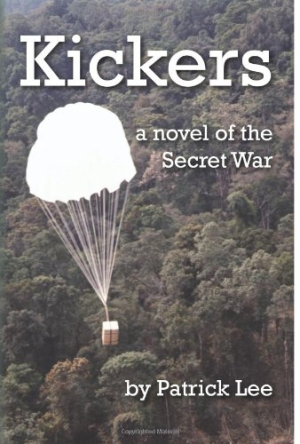Kickers
a novel of the Secret War
Spot-on details shed light on a seldom discussed episode in American foreign policy.
If high school history teachers assigned stories like Patrick Lee’s Kickers, students would learn a lot more about the conflicts that have shaped our world than they ever would from a typical textbook. It may be fiction, but Lee’s on-the-ground account of covert CIA operations in Laos during the 1960s rings true. Based on interviews with the civilian firefighters recruited for these clandestine maneuvers, Kickers captures the naive and courageous voices of the young American men secretly dispatched to halt the spread of communism across Southeast Asia.
The firefighters at the heart of Lee’s story are a special breed. They’re smoke jumpers in the United States, young men trained to parachute into dangerous wildfires to keep them from spreading. The book tells of Thanasis, Charlie, and Dog as they trade affectionate barbs and grow a boot-camp bond. Lee, a former smoke jumper himself, clearly knows his subject. From Dog’s lonely days as a fire tower lookout in Idaho to harrowing forest landings gone wrong, Lee paints a clear picture of the life of a smoke jumper.
The first half of Kickers is largely devoted to these young thrill seekers and their growing camaraderie, though Lee hints at things to come with dark prisoner-of-war scenes that foreshadow the nightmare the buddies will ultimately face on the other side of the world. The POW scenes are grim and visceral, taking us into a world where desperate prisoners will urinate on the floor of their jungle prison in hopes of loosening the bars that hold them and where escapees will drink river water, tadpoles and all, in order to survive.
Lee doesn’t fully immerse his characters into the conflict in Laos until fairly late in the book, and while the macho banter of boot camp feels authentic, it may go on a bit too long. This is a story about “kickers” after all, the men who push cargo—rice and ammunition—from airplanes to supply forces on the ground in a war zone. The leisurely pace in the early sections can be a frustrating wait before the true action begins.
Once in Laos, however, Lee provides spot-on details that shed light on a seldom discussed episode in American foreign policy. For instance, when Lee details the nearly impossible pilot training of Meo tribesmen—a people with no understanding of written language or numbers—he reveals the CIA’s desperate efforts to employ only civilians in the Laos effort and thus stand by the letter of the law agreed to at the Geneva Convention.
While Lee’s experience is evident, his story would be more affecting with a deeper investigation of one or more characters’ understanding of the events. The third-person perspective allows him to dip into each man’s experience but doesn’t delve deeply into individual motivations. Additionally, instead of letting the characters reveal the plot, the book often turns to exposition, explaining the politics from outside the narrative.
Kickers would also benefit from more refined cover art, as the spare image of a lone parachute belies the complex issues Lee examines in the text. Those who look inside will be rewarded with an insider’s view of a complex time in US history.
Reviewed by
Sheila M. Trask
Disclosure: This article is not an endorsement, but a review. The publisher of this book provided free copies of the book and paid a small fee to have their book reviewed by a professional reviewer. Foreword Reviews and Clarion Reviews make no guarantee that the publisher will receive a positive review. Foreword Magazine, Inc. is disclosing this in accordance with the Federal Trade Commission’s 16 CFR, Part 255.

